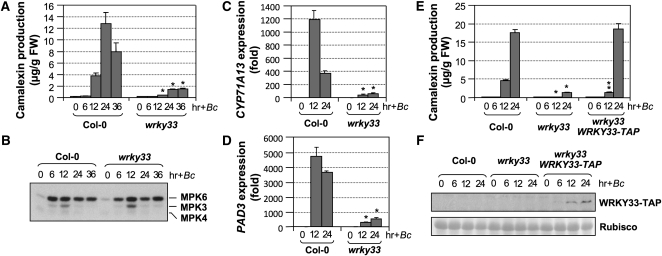Figure 2.
WRKY33 Is Essential to Camalexin Induction in Arabidopsis after B. cinerea Infection.
(A) Mutation of WRKY33 compromised B. cinerea–induced camalexin biosynthesis. Two-week-old wild-type (Col-0) and wrky33 seedlings were inoculated with B. cinerea spores, and camalexin accumulation was measured at indicated times. Error bars indicate se (n = 3). FW, fresh weight.
(B) MPK3/MPK6 activation in the wrky33 mutant was not affected. MAPK activation in these seedlings was determined by an in-gel kinase assay using MBP as a substrate.
(C) and (D) Activation of camalexin biosynthetic genes, including CYP71A13 (C) and PAD3 (D), was compromised in the wrky33 mutant. Transcript levels were determined by real-time qPCR. Error bars indicate se (n = 3).
(E) Complementation of wrky33 mutation by a native WRKY33 promoter-driven WRKY33-TAP construct. Error bars indicate se (n = 3).
(F) Induction of WRKY33-TAP protein in WRKY33-TAP/wrky33 plants by B. cinerea. Total protein extracts prepared from seedlings shown in (E) were subjected to immunoblot analyses using a goat anti-IgG-HRP conjugate to detect the TAP-tagged WRKY33 (top). Equal amounts (10 μg) were loaded to each lane and were confirmed by Ponceau S staining (bottom). Statistically different data groups at a specific time point (P value < 0.05) are indicated using different numbers of asterisks (0 to 2) vertically placed above the columns in the graphs.

